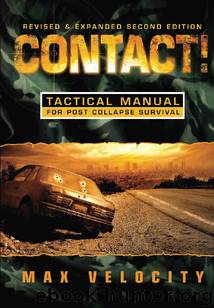Contact! A Tactical Manual for Post Collapse Survival by Max Velocity

Author:Max Velocity [Velocity, Max]
Language: eng
Format: epub
Tags: Sports & Recreation, Martial Arts & Self-Defense
ISBN: 9781478106692
Google: msh8MAEACAAJ
Amazon: 1478106697
Publisher: Createspace Independent Pub
Published: 2012-07-02T07:00:00+00:00
Figure 6 - Peeling to the Right
With the peel, when the formation needs to move right, individuals or elements will move from the left side, behind the formation, and peel back in on the right. The opposite for moving left. As each individual passes the next man, who will be providing suppressive fire, he shouts something along the lines of “Move!” or “Last man!” or kicks his foot etc., in order to ensure that the next man knows to move.
The technique is a flow of constant fire and movement. It can also be used, for example, as a way of moving to a flank out of an area of open ground to cover, when contacted by an enemy to the front.
Angles of Fire & Flanking
Never underestimate the power of moving to the enemies flank. When conducting F&M, you will be moving in an imaginary ‘lane’. As you get closer to the enemy, you will start to obscure each other’s fields of fire as one buddy moves forward of the other. If you are spaced correctly apart, this effect will be reduced. The best way to assault an enemy is with the fire support element at a 90 degree angle to the assaulting element. This will mean that the assaulting element does not get in the arcs of fire of the supporting element until they actually get onto the position, at which point the supporting fire element will simply switch their fire away to either the left or right depending on the side which the assault element is coming in from.
By maneuvering to the flank you can also gain tactical surprise, regain the initiative and gain psychological advantage over the enemy; doing this can gain you a psychological victory where you break the enemy’s cohesion and will to fight, causing them to flee or withdraw. There will be more on the specific tactics of maneuvering to the flank later. Consider that if you are engaged and you leave a fire support element in place, then you take a concealed route to the enemies flank with an element of your group, you will allow your fire support element to continue to engage the enemy as you maneuver onto the position.
You will also tactically surprise the enemy and this is where the psychological element also comes in. The enemy will be unbalanced by your flanking move and will fear being cut off, ‘rolled up’ and overrun. If you continue to keep the pressure on and assault towards the enemy, you will either cause them to flee, surrender, or continue to fight on so that you have to fight through and clear the position, in which case you will at least have the benefit of the 90 degree assault/fire support angle to give you maximum protection as you close with the position.
Tactical Terrain Terms
It is important to develop an infantryman’s eye for the ground. When you are driving about, you won’t be thinking about how pretty it all looks, rather, you will be noticing the way the ground is shaped and how there are certain folds, dips and higher areas.
Download
This site does not store any files on its server. We only index and link to content provided by other sites. Please contact the content providers to delete copyright contents if any and email us, we'll remove relevant links or contents immediately.
Shoe Dog by Phil Knight(4222)
The Rules Do Not Apply by Ariel Levy(3949)
Walking by Henry David Thoreau(3263)
Running Barefoot by Amy Harmon(3081)
How to Read Water: Clues and Patterns from Puddles to the Sea (Natural Navigation) by Tristan Gooley(2910)
Crazy Is My Superpower by A.J. Mendez Brooks(2890)
I'll Give You the Sun by Jandy Nelson(2867)
How to Read Nature by Tristan Gooley(2690)
How Music Works by David Byrne(2573)
The Boy, the Mole, the Fox and the Horse by Charlie Mackesy(2486)
Seducing Cinderella by Gina L. Maxwell(2256)
Cuba by Lonely Planet(2210)
The Fight by Norman Mailer(2181)
Going Long by Editors of Runner's World(1940)
Accepted by Pat Patterson(1934)
The Unfettered Mind: Writings from a Zen Master to a Master Swordsman by Takuan Soho(1881)
The Happy Runner by David Roche(1847)
Backpacker the Complete Guide to Backpacking by Backpacker Magazine(1838)
Trail Magic by Trevelyan Quest Edwards & Hazel Edwards(1779)
